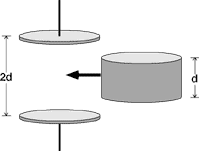A2L Item 245
- Description: Identify the electrical quantities that change when a metallic cylinder is placed in an isolated capacitor.
- Goal: Reason and link electrical quantities.
- Source: 283-Del C, E, U, etc - cstQ
- Keywords: Reasoning, Electromagnetism, Capacitors
The question for students:

Two parallel conducting plates form a capacitor. It is isolated and a charge Q is placed on it. A metal cylinder of length half the plate separation is then inserted between the plates. Which of the quantities C, ΔV, Q, E, and U change?
- C, E, and U only
- ΔV and U only
- C and U only
- E and U only
- C, ΔV, and U only
- ΔV and E only
- C and ΔV only
- None of the above
Commentary for teachers:
Answer
(8) Students who are formula bound find this a difficult question. Obviously Q does not change. Depending on how students interpret the question, they may conclude that E does or does not change. The value of E in regions outside the cylinder does not change [Students taking this interpretation may respond #5.], but inside the cylinder it is now zero. Since E is now zero for half of the distance between the original plates, both ΔV and U must change. That C also changes can be appreciated in many different ways.
There are many good follow up questions, such as: Does it make a difference where the cylinder is placed? How would the quantities change if the cylinder was made of a dielectric material? Suppose a half cylinder of length 2d were placed between the plates. How would quantities change?